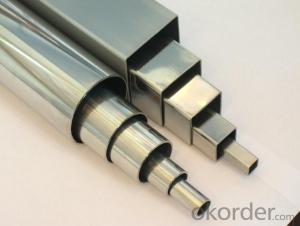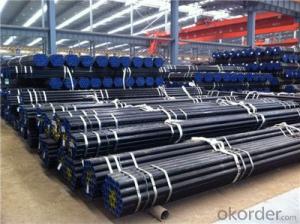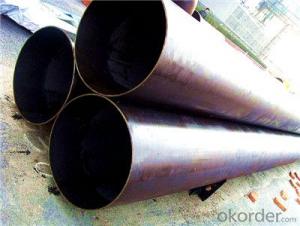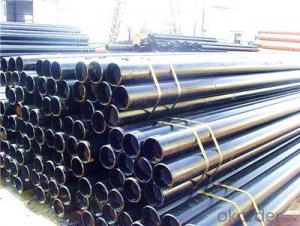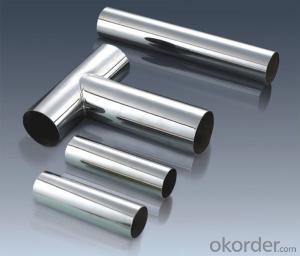Low price Hot sale 304/304l stainless steel bar
- Loading Port:
- Tianjin
- Payment Terms:
- TT OR LC
- Min Order Qty:
- 100 kg
- Supply Capability:
- 1000 kg/month
OKorder Service Pledge
Quality Product, Order Online Tracking, Timely Delivery
OKorder Financial Service
Credit Rating, Credit Services, Credit Purchasing
You Might Also Like



- Q: What is stainless steel decorative tube? What uses does it have?
- Is a hollow steel strip, used as pipe conveying fluid, such as oil, gas, water, gas, steam, in addition, the bending and torsional strength of the same, the weight is light, so it is widely used in the manufacture of machinery parts and engineering structures. It is also used to produce all kinds of conventional weapons, guns, shells and so on.
- Q: Can stainless steel pipes be coated with PTFE?
- Yes, stainless steel pipes can be coated with PTFE (polytetrafluoroethylene) to improve their corrosion resistance, reduce friction, and provide a nonstick surface. The PTFE coating creates a protective barrier on the stainless steel, making it suitable for various applications in industries such as chemical processing, food processing, and pharmaceuticals.
- Q: How do you calculate the pipe length required for a specific application?
- To calculate the pipe length required for a specific application, there are several factors that need to be considered. 1. Flow Rate: Determine the desired flow rate or the amount of fluid to be transported through the pipe per unit of time. This can be measured in gallons per minute (GPM), liters per second (L/s), or any other appropriate unit. 2. Pipe Material: Identify the material of the pipe that will be used for the application. Different materials have different friction coefficients, which will affect the overall length required. 3. Friction Loss: Calculate the friction loss in the pipe based on the flow rate and the material properties. This involves determining the friction factor for the specific pipe material and using the appropriate equation (such as Darcy-Weisbach equation or Hazen-Williams equation) to calculate the friction loss. 4. Pressure Drop: Consider the desired pressure drop across the pipe. This is typically specified by the application requirements or system design. The pressure drop can be calculated using the Bernoulli's equation or other relevant equations. 5. Pipe Diameter: Determine the appropriate pipe diameter based on the desired flow rate and the allowable pressure drop. This can be done by using pipe sizing charts or equations specific to the pipe material and the flow characteristics. 6. Pipe Length Calculation: Once the pipe diameter is known, calculate the length required based on the desired flow rate, pressure drop, and the friction loss. This can be done using various pipe sizing equations or software tools available for the specific pipe material. 7. Additional Factors: Consider any additional factors that may affect the pipe length calculation, such as elevation changes, fittings, valves, or other components in the system. These factors may introduce additional friction losses or pressure drops that need to be accounted for. It is important to note that pipe length calculations are typically performed by engineers or professionals with expertise in fluid mechanics and pipe system design. Consulting relevant codes, standards, and guidelines specific to the application is also recommended to ensure compliance with safety and performance requirements.
- Q: Ask experts, 304 stainless steel pipe why rust?
- Stainless steel is not easy to rust and has a lot to do with the composition of stainless steel. In addition to iron, stainless steel contains chromium, nickel, aluminum, silicon and so on. General stainless steel chromium content is generally not less than 12%, high even up to 18%. Steel added elements such as chromium, can change the performance of the steel, such as the molecular structure of steel more uniform on the surface of the steel is more easily to form a layer of dense oxide protective film, thereby greatly improving the ability of corrosion-resistant stainless steel. Therefore, stainless steel can resist fire, water, acid, alkali and various solutions to its corrosion, not rust. The scientists found that the internal structure of the steel is more uniform, various components more closely linked to the corrosion of the more difficult the invasion, also attached to the surface with a layer of oxide film, like iron and steel to wear armor, was not naturally easy to rust.
- Q: Are stainless steel pipes more expensive than other materials?
- Stainless steel pipes are generally more expensive than other materials, but they offer significant advantages that justify their higher cost. Stainless steel pipes are known for their exceptional durability, corrosion resistance, and longevity. They can withstand extreme temperatures, harsh chemicals, and high pressure, making them suitable for a wide range of applications such as construction, plumbing, and industrial processes. Additionally, stainless steel pipes require minimal maintenance, reducing long-term costs. While the initial investment may be higher, the superior performance and extended lifespan of stainless steel pipes make them a worthwhile choice in many scenarios. Ultimately, the decision to choose stainless steel pipes should be based on the specific requirements and budget constraints of the project.
- Q: Can stainless steel pipes be insulated with polyethylene terephthalate?
- Yes, stainless steel pipes can be insulated with polyethylene terephthalate (PET). PET is commonly used as an insulating material due to its low thermal conductivity, high melting point, and good resistance to moisture, chemicals, and UV radiation. It can be applied as a protective coating or as a wrap around the stainless steel pipes to prevent heat loss or gain. PET insulation can be easily installed and is highly effective in reducing energy transfer, making it suitable for various applications in industries such as HVAC, plumbing, and oil and gas.
- Q: What is the difference between Type 304 and Type 316 stainless steel pipes?
- Type 304 and Type 316 stainless steel pipes find wide application in diverse industries, each possessing distinct composition and physical characteristics. Type 304 stainless steel, a versatile and commonly utilized grade of stainless steel pipe, boasts a higher proportion of chromium and nickel compared to Type 316. Consequently, it exhibits exceptional resistance to corrosion and durability. Type 304 proves ideal for situations where exposure to corrosive substances remains minimal, such as indoor settings or general-purpose utilization. In contrast, Type 316 stainless steel pipes are renowned for their superior corrosion resistance, particularly in more hostile environments. They contain a higher proportion of molybdenum, which bolsters their ability to withstand pitting and crevice corrosion caused by chloride solutions, like seawater or saltwater environments. This renders Type 316 stainless steel pipes suitable for marine applications, chemical processing plants, and situations where exposure to harsh chemicals or high temperatures is inevitable. Regarding physical properties, Type 316 stainless steel pipes exhibit greater tensile strength and yield strength when compared to Type 304. Consequently, they can endure higher pressures and display enhanced resistance against deformation or cracking under stress. In summary, the primary distinction between Type 304 and Type 316 stainless steel pipes lies in their corrosion resistance and physical properties. Type 304 proves suitable for general-purpose use and indoor environments, while Type 316 is preferred for applications necessitating superior corrosion resistance and strength, particularly in aggressive or high-temperature conditions.
- Q: What is the difference between 321 and 347 stainless steel pipes?
- The main difference between 321 and 347 stainless steel pipes lies in their composition. While both grades contain similar amounts of elements such as chromium and nickel, 321 stainless steel contains the addition of titanium, which stabilizes the material against chromium carbide precipitation during welding. On the other hand, 347 stainless steel contains the addition of niobium, which also helps to prevent carbide precipitation and provides enhanced resistance to intergranular corrosion. Therefore, the choice between 321 and 347 stainless steel pipes will depend on the specific application and the desired level of resistance against carbide precipitation and intergranular corrosion.
- Q: Can stainless steel pipes be insulated with polystyrene sulfonate?
- Stainless steel pipes have the capability to be insulated using polystyrene sulfonate. Polystyrene sulfonate is frequently employed as an insulation material due to its remarkable thermal and moisture resistance characteristics. Its application onto stainless steel pipes aids in the reduction of heat loss or gain and the prevention of condensation. This insulation material is known for its durability and long-lasting performance, making it a popular choice. Nonetheless, it is crucial to ensure that the polystyrene sulfonate insulation is suitable for the specific application and complies with all necessary safety and regulatory standards.
- Q: Are stainless steel pipes resistant to high temperatures?
- Yes, stainless steel pipes are highly resistant to high temperatures.
Send your message to us
Low price Hot sale 304/304l stainless steel bar
- Loading Port:
- Tianjin
- Payment Terms:
- TT OR LC
- Min Order Qty:
- 100 kg
- Supply Capability:
- 1000 kg/month
OKorder Service Pledge
Quality Product, Order Online Tracking, Timely Delivery
OKorder Financial Service
Credit Rating, Credit Services, Credit Purchasing
Similar products
Hot products
Hot Searches
Related keywords









